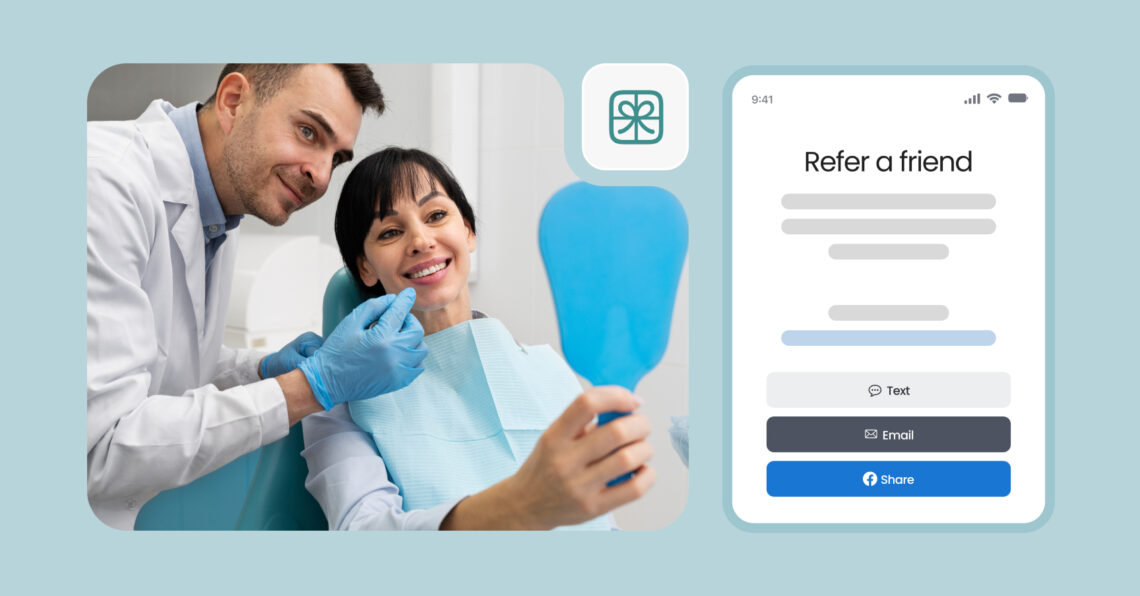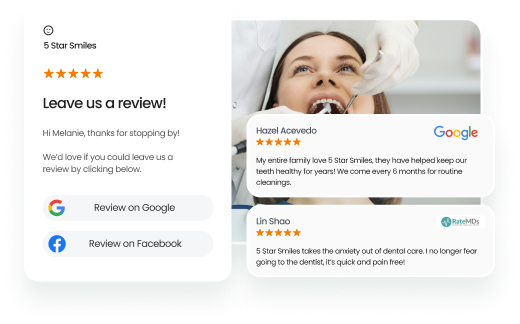People tend to trust recommendations from those they know, especially when it comes to healthcare decisions. According to Nielsen, 92% of consumers trust referrals from friends and family more than any other form of advertising. That trust is especially powerful in healthcare.
When a happy patient recommends your dental practice to someone they know, it feels more genuine and reliable than any paid campaign. This kind of word-of-mouth advertising is at the core of a successful dental referral program and one of the most effective ways to grow sustainably.
Yet many dental practices continue to prioritize paid ads over referrals. While advertising may bring attention, it often lacks the trust that comes from a personal recommendation. A referred patient is usually more confident in their decision and more likely to schedule a visit.
Referral programs strengthen patient relationships, and people who feel appreciated often return and refer others.
In this blog, we’ll guide you step-by-step on how to create a patient referral system that attracts new patients, builds trust, and strengthens your dental reputation in the community.
Table of contents
- What is a dental referral program
- Benefits of the dental referral program
- How to build an effective dental referral program
- Legal and ethical considerations for dental referral programs
- How Birdeye helped Steele Creek Pediatric with dental referrals
- Building a patient referral program for steady growth
- Frequently asked questions on the dental referral program
- How Birdeye supports and scales your dental referral program
What is a dental referral program
A dental referral program is a patient growth strategy that encourages current patients to refer friends, family or colleagues to your practice. In return, to show appreciation, the referring patients are offered some incentives to thank them for their loyalty and support.
These programs rely on personal recommendations, which are often more trusted and influential than traditional forms of advertising.
Common dental referral program ideas
- Discounts on future dental treatments or procedures.
- Free cosmetic services, such as teeth whitening or fluoride treatments.
- Gift cards to popular retailers or local businesses.
- Points-based rewards systems where patients earn points for each referral and can redeem them for services or products.
- Free products like toothbrushes, whitening kits, or dental care bundles.
- Raffles to reward participation by referring patients into a monthly prize draw.
- Birthday treats during the referrer’s birthday month, such as a free fluoride treatment.
Benefits of the dental referral program
A dental referral program offers a straightforward and effective way to expand your practice while developing stronger relationships with both new and existing patients. I
Let’s explore some of the key benefits of this approach.
1. Affordable way to attract new patients
Referral programs provide a cost-effective method to attract prospective patients. Recommendations from satisfied patients build credibility and encourage others to make appointments.
2. Builds stronger bonds with patients
Referrals boost your reputation by increasing awareness and credibility in your community. As more patients talk about your practice, it becomes a trusted name people are more likely to choose.
3. Boosts your reputation
Positive word-of-mouth strengthens how your practice is viewed and helps build trust within the community. As referred patients share their experiences, your name becomes more recognizable and respected locally.
In a nutshell, a well-executed dental referral program does not just grow your practice; it builds a stronger, more engaged patient community that supports long-term success.
How to build an effective dental referral program
A referral program is one of the most practical ways to attract new patients and strengthen your relationship with current ones.
Here’s how to build a program that works and is easy to maintain.
1. Define your goals and audience
Start by identifying what you want to achieve. Are you trying to:
- Increase the number of new patients?
- Reach a specific group, like families or young adults?
- Promote certain services, such as cosmetic dentistry?
Focus on your most satisfied and loyal patients. They’re the ones most likely to refer to others. Design your new patient referral program to fit their needs, habits, and preferences.
2. Offer simple and meaningful rewards
Your incentives should be reasonable, legally appropriate, and worth the effort it takes to refer someone. They don’t need to be expensive, but they should feel personal and valuable.
Examples:
- Free cleaning or whitening service
- Discounts on future visits
- Gift cards to local stores or restaurants
- Branded dental care items
- Entry into a raffle or small prize drawing
Tip: Check with local dental boards or health authorities to ensure your incentives comply with regulations.
3. Make it easy to participate
Patients are more likely to participate if the process is quick and clear. Avoid making them jump through hoops.
Ways to streamline the referral process:
- Create a dedicated referral landing page on your website
- Include QR codes on printed materials and posters
- Provide referral links by email or text
- Display clear information in your dental office
- Hand out small referral cards with contact details
- Ensure your practice management software or CRM can track referrals
4. Promote the program consistently
Inform your patients about the program’s existence. Many referral efforts fall flat simply because people don’t hear about them often enough.
Ways to share it:
- Mention it in your regular emails and newsletters
- Post reminders on social media
- Add it to appointment reminders
- Display signs and cards in your waiting area
- Have staff mention it casually during visits
- Include referral messaging in thank-you notes, birthday cards, or follow-ups
The more consistent your efforts are for this program, the more likely patients are to remember and take part.
5. Provide a good patient experience every time
Patients would not refer friends or family unless they are happy with their own visits. That means every appointment should be comfortable, well-organized, and handled professionally.
Key areas to focus on:
- Friendly and helpful staff
- Clean and welcoming office
- Clear communication about treatment plans and costs
- Reliable follow-up and support
- Prompt responses to questions or concerns
- Strong online presence with positive reviews
You can also share positive reviews and testimonials to remind others of what makes your practice stand out.
6. Involve and align your dental team
Make sure your staff understands the referral program and can explain it to patients without confusion. Everyone should be on the same page.
What your team should know:
- How the program works
- How to bring it up in conversation
- How to answer common questions
- How referrals are tracked and acknowledged
How to integrate it into the workflow:
- Assign a referral champion to manage and track the program
- Include referral training in team onboarding and meetings
- Add referral prompts during patient intake and checkout steps
- Create simple scripts and SOPs for consistent promotion
When the entire team supports the program, it becomes part of everyday interactions.
7. Community involvement and partnerships
Working with other businesses or participating in community events provides additional opportunities to expand your referral network.
Suggestions:
- Partner with local businesses: Collaborate with local businesses, such as gyms, salons, or coffee shops, to offer shared promotions. (For example- “Refer a friend and get a free coffee from [Local Café]”).
- Sponsor or attend community events: Use local events like dental health community fairs, school events, or health expos to introduce your practice and highlight the referral offer.
8. Use social media to amplify your referral program
Social platforms like Instagram, Facebook, TikTok, etc, are where many of your patients already spend time, so make it effortless for them to share your offer and tag friends.
9. Measure results and make adjustments
Keep track of how the program is performing so you know what’s helping and what might need improvement.
Things to monitor:
- Number of referrals per month: Total number of referred leads generated each month
- Referral-to-patient conversion rate: Percentage of referred leads who book and attend appointments
- Source of referrals: Identify which patients, staff members, or campaigns are driving the most referrals
- Top referrers: Highlight individuals who consistently refer others, and consider recognizing them
- Cost per referral: Average incentive or marketing cost per referred patient
- Return on investment (ROI): Compare the long-term value of referred patients against the cost to acquire them
- Incentive performance: Track which rewards result in higher engagement and conversions
10. Additional dental referral program ideas
- Referral cards: Give patients small cards they can hand to friends, printed with your contact info and a referral message.
- Personal thank-yous: Send handwritten notes or emails to thank patients who refer someone.
- Review requests: Ask satisfied patients to leave online reviews, which can also bring in new patients.
- Office signage: Keep posters or table cards in your waiting area to remind patients about the program.
- Onboarding and check-out prompts: Mention the program when patients check in, check out, or complete treatment.
A well-planned referral program doesn’t need to be complicated. With the proper structure, consistent communication, and a focus on patient satisfaction, your practice can build steady growth through trusted word-of-mouth.
Build a Successful Dental Referral Program Now!
Want to see the impact of Birdeye on your business? Watch the Free Demo Now.
Legal and ethical considerations for dental referral programs
Before launching your referral program, it’s important to ensure it complies with healthcare-related legal and ethical standards. Referral rewards in dentistry must follow specific regulations governed by:
- HIPAA (Health Insurance Portability and Accountability Act)
- Your state’s dental board laws
- Professional organizations such as the ADA
To keep your program compliant:
- Avoid offering cash incentives for referrals.
- Keep rewards modest and healthcare-related, such as dental products or service discounts.
- Always disclose that the referring patient may receive a reward (e.g., “You may receive a gift for referring”).
- When in doubt, consult legal counsel or your compliance officer to review your program before launching.
Following these guidelines ensures your referral program remains effective, trustworthy, and legally sound.
How Birdeye helped Steele Creek Pediatric with dental referrals
Steele Creek Pediatric is a three-location dental practice in Charlotte, NC, with five pediatric specialists dedicated to caring for children and individuals with special needs in a fun, supportive environment.
They had strong relationships with patients but struggled to convert that satisfaction into consistent referrals. Staff members would occasionally ask for referrals in person, but this approach was inconsistent and often forgotten during busy times.
Birdeye provided a way to manage community outreach more reliably.
1. Automated referral requests
Using Birdeye, Steele Creek Pediatric began sending referral requests automatically after appointments. This ensured that each satisfied patient had a clear opportunity to refer others, without requiring staff to follow up manually.
2. Simple referral process for families
Patients could refer friends or family by clicking a link sent through text or email. This reduced the number of steps needed and made participation more likely.
3. More new patients through referrals
As referral requests increased, more families shared their experience with others. Along with the rise in online reviews, the number of new patients grew. Birdeye helped make patient feedback more visible and easier to share.
Birdeye’s tools helped Dr. Goodman and his team track the performance of referrals at each location. This made it easier to see where things were working well and where minor adjustments were needed.
By using Birdeye to support their referral program, Steele Creek Pediatric was able to reach more families while keeping the process simple for both patients and staff.
Building a patient referral program for steady growth
A well-designed patient referral system helps your dental practice grow by encouraging patients to share their positive experiences with others. Keeping the process simple, offering meaningful rewards, and communicating clearly will motivate patients to participate.
Regularly reviewing your program’s performance ensures it stays adequate and relevant. This approach not only attracts new patients but also develops loyalty, laying the foundation for long-term success.
Frequently asked questions on the dental referral program
It’s a dental marketing strategy where current patients refer friends or family to your practice in exchange for rewards, such as discounts or complimentary services.
Referral marketing incentivizes existing customers to bring in new ones through trusted, word-of-mouth recommendations.
Referral programs attract loyal patients cost-effectively, boost your reputation, and increase patient retention through trusted word-of-mouth.
Simple rewards like free cleanings, discounts, gift cards, or branded dental products are popular and motivate participation.
Use digital links, QR codes, referral cards, and clear communication both online and in your office.
Monitor referral sources, new patient appointments, and conversion rates to see what’s working and optimize accordingly.
How Birdeye supports and scales your dental referral program
Birdeye provides dental practices with tools to manage referral programs in the dental industry more efficiently. It reduces the manual effort involved and helps you keep track of results, while making it easier for patients to refer others.
- Referral requests sent automatically: You can set up Birdeye to send referral requests after key moments, like receiving a 5-star review or completing an appointment. This keeps your program consistent and ensures you’re reaching happy patients when they’re most likely to share.
- Simple referral sharing: Patients can easily refer friends or family by text, email, or social media using links generated through Birdeye. These links are quick to send and don’t require any special steps.
- Custom-branded referral templates: Birdeye allows you to create referral messages that align with your brand. You can adjust the wording, design, and referral form as needed, and include rewards like discounts or free products to encourage participation.
- Real-time tracking and insights: See exactly how your referral program is performing. Track who’s referring, which messages are working best, and how many referrals convert to booked appointments, all in one simple dashboard.
- Built-in integrations with your dental systems: Birdeye integrates with your existing practice management software to keep referrals streamlined. No need to juggle multiple tools or duplicate data.
- Quick responses to new referrals: When someone follows a referral link or messages your office, Birdeye’s inbox and chatbot can reply automatically or notify your staff to respond, so you never miss an opportunity.
With Birdeye, your referral program runs in the background, automated, measurable, and scalable, so your team can stay focused on delivering great patient care while your practice keeps growing.

Originally published









